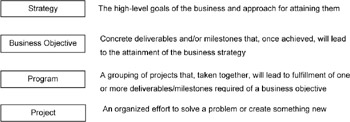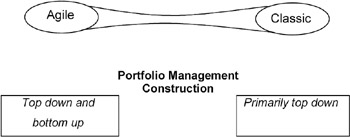Creating Your Portfolio View
When getting started with portfolio management, or when performing a comprehensive review of a current process, it makes sense to start at or near the top. However, this isn't always necessary, especially if you're just getting started with formal portfolio management. In this case, it may make sense to start from both ends, and see if and where they meet. The general hierarchy for mapping a project portfolio is strategy, then business objectives, then programs, and finally projects (see Figure 11-7). In the final portfolio, you should have a clear understanding of how every project you're working on supports one or more strategies. For this reason, the result of this mapping process is referred to as the Portfolio View.

Figure 11-7: Portfolio mapping hierarchy.
One approach is to list your business strategies across the top of a whiteboard. Then lay out the high-level business objectives under each strategy. Under each business objective, list programs and then projects. This sounds pretty easy, but it may become confusing. You may discover that things don't line up into neat columns. Some projects map to multiple programs; some programs map to multiple objectives; and some things don't map to anything. Very soon, you may have a complex and tangled web that will make your head spin.
Because the agile portfolio is influenced just as much from the bottom levels of the organization (where projects reside) as the top, you may find that the classic top-down methods of portfolio construction do not always work smoothly. You may find, for instance, that lower-level projects are significantly disjointed. There may be numerous, loosely linked efforts proceeding simultaneously without a strong objective tying them together. In this case, you would need to start at the bottom and first organize your projects, then your programs. You will probably identify some overlap as well as gaps that need to be addressed. At the same time, you may start to go down your list of business strategies and see if they meet the bottom-up projects and programs. Most likely, you won't have a clean linkup. You will have to work to get everything into alignment by nudging the project portfolio, the business strategy, or both.
The agile environment is one of discovery and breaking new ground. Its inherent nature encourages grass-roots efforts to address challenges. As project, program, portfolio, and executive managers, we need to recognize that not all projects will be driven from the top down. In fact, significant projects will initiate themselves among the core rank and file. Some of these grass-roots efforts may actually create a profound influence on top-level business strategies. In this situation, it is imperative that you initially construct your project portfolio with a strong bottom-up perspective (see Figure 11-8).

Figure 11-8: Portfolio construction in an agile versus classic environment.
There are many ways to help organize your current portfolio, and all of them involve a little brute force and cranking through details. The exercise itself will involve many parts of the organization, and it can be very beneficial, if conducted correctly and tactfully. Organizing your portfolio "correctly" means that all linkages and dependencies are captured and understood. It is especially important to recognize the lower-level, interproject dependencies that are often overlooked but, if not understood, can end up wreaking havoc on a higher-level program or objective. Working "tactfully" means that portfolio management is an emotional and political exercise. You need to take an objective perspective when creating your overall portfolio mapping. If you are too subjective or let personal preferences, pet projects, or a silo mentality enter into the mix, then you may find that every project supports every strategy and that all are equally important. This may be true, but probably isn't, which means that you won't get the added value that you need from portfolio management.
In-depth discussions to prioritize projects are required to get and keep the portfolio aligned. These efforts may be painful and unpopular, but they are essential to maintain business agility.
Making sense out of a tangled web of projects is hard work, but you need to do it. You'll learn a lot about what your organization is working on, what it thinks is important, and how it works. You will probably even revisit some of your high-level strategies. This is all good. Additionally, once you've worked through this process, you will have created your Portfolio View, which provides an excellent, one-page, big-picture view of your business (for a more detailed example of a Portfolio View, see Appendix D). This, in turn, enables your portfolio management process to be integrated into your day-to-day operational project management processes for maintenance and reporting purposes.
EAN: 2147483647
Pages: 96